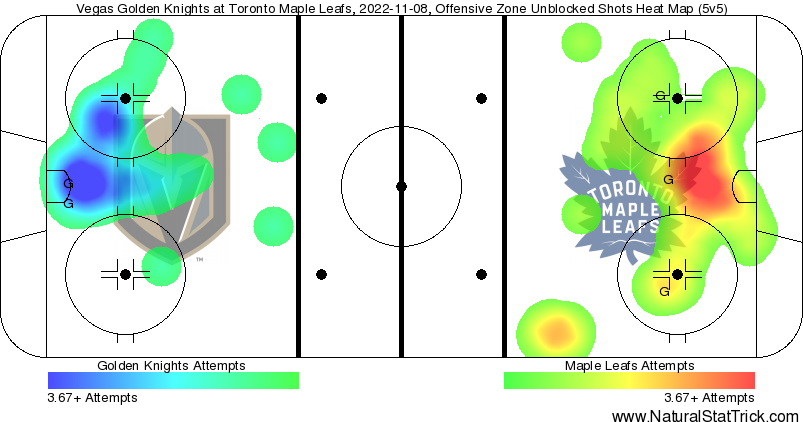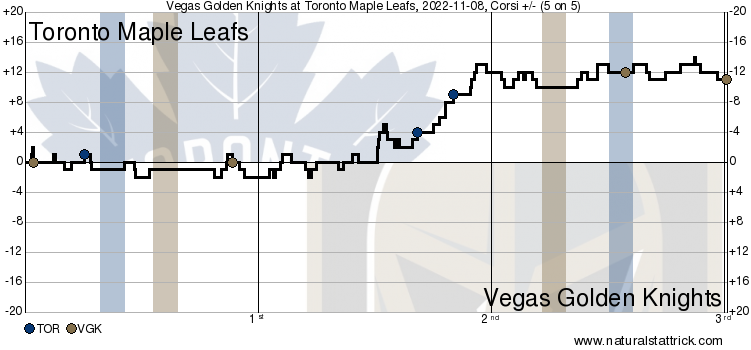The Maple Leafs let the opportunity to end another long winning streak of a top opponent slip through their grasp against the Vegas Golden Knights on Tuesday night.
Two unforced errors by Leafs in the first period (via Timothy Liljegren and Rasmus Sandin) led to goals against, but they overcame the 2-1 deficit in the second period and were in control of the game halfway through the third, with the template of excellent close-out efforts against Carolina and Boston fresh in the memory bank. However, a shorthanded goal against followed by a 3v3 OT period that was over before it really started ended in a dropped point.
You’ll take five of six points from a three-in-four-nights stretch against Boston, Carolina, and Vegas, no questions asked. But there is also the nagging feeling this could’ve been a fantastic three-game sweep if the attention to detail was a little sharper to end the game.
Then again, the Leafs conceded more than enough breakaways in this game to leave with no points at all.
Your game in 10:
1. I recognize I am starting with the end of the game first here, but I want to begin with this stat, which I thought was remarkable: Over the last three seasons, with the trio of Morgan Rielly, Auston Matthews, and Mitch Marner on the ice in three-on-three overtime, the Leafs have been outscored by a whopping 8-1 margin.
Obviously, wringing our hands about three-on-three missed assignments — it was Marner’s tonight — or three-on-three OT records at all is silly to some degree; it’s not a game state that ever plays a role at playoff time (except in extremely rare circumstances), and it’s not something the coaching staff is burning precious practice time on during the grind of an NHL schedule.
However, for such an offensively-talented team, the Leafs should be collecting more of these OT points, and it plays a notable role in their regular-season standings finish. They’re now 1-3 this season in OT (the one winner was Nick Robertson’s vs. Dallas), which leaves them at 7-9 since the start of last season. Florida won the 2021-22 President’s Trophy in part thanks to a 13-2 OT record.
When Matthews and William Nylander have been on the ice together, the Leafs have four OT game-winners and zero against over the past three seasons.
I am not looking to blow this out of proportion by any means nor am I blaming any one individual player, but it would seem to behoove the coaching staff to at least be aware of these numbers and perhaps switch it up to start the OT period.
2. Four goals on 20 shots for a .800 save percentage is a brutally unfair reflection of Erik Källgren’s play in this game. Before the Leafs turned it on in the second half of the second period, the score could’ve easily been 4-1 Vegas.
Källgren faced five breakaways in this game and made the first save on all of them (the first breakaway, just a few seconds into the game, was finished off on the second opportunity). There was also a big save on a back-post cross-crease play on the third-period Vegas power play which gave the Leafs a chance to close out a win in regulation in the first place.
The Leafs protected Källgren really well defensively in the third period against Boston and all throughout the Carolina game, and when they were actually defending inside their structure in the defensive zone tonight, they mostly continued to do so. However, the turnovers leading to quick transition opportunities against and the number of Vegas forwards they let in behind them through the neutral zone were far too plentiful in this game. It was a little disappointing given it was just a couple of weeks ago that the Leafs saw how dangerous this Vegas team is in transition if they don’t take care of the puck.
To me, Källgren’s deserving of either the Leafs’ first or second-star nod in this game. He played a huge role in collecting this point, and it couldn’t have been a harder game to play in for a goalie: very few shots against, but it felt like half of them were fast-developing point-blank scoring chances.
3. Another obvious bright spot in the game was Mitch Marner’s play in the second period leading to the two Leaf goals. Between his beautiful setup on the game-winner in Carolina, his stunning goal tonight, and his slick setup for the 3-2 Timothy Liljegren goal, we’ve now seen three of those dazzling, game-changing Marner plays at critical times in games in the past four periods of play, leading to points in the standings against high-end opposition.
You could see the instant impact of that fantastic individual goal-scoring effort on his confidence, his body language, and his skating legs. You knew there was more to come from him in the game. After a relatively slow start and a lot of unwanted attention on him in the media, Marner appears to be coming out the other side of it now.
🪄🤯 THOSE MAGIC MITTS!!!!!!!! 🤯🪄 pic.twitter.com/kCEltoq57c
— Toronto Maple Leafs (@MapleLeafs) November 9, 2022
4. On the other hand, this was one of about a half-dozen games so far this season where it appeared that Auston Matthews was uncharacteristically fighting the puck for chunks of the game. Of course, he’s still finding ways to score, but it’s been a little strange to witness.
With just two even-strength goals in 14 games from the league’s best even-strength goal scorer, there is still so much more to give here. The back-to-back Rocket Richard winner is obviously not going to end the season 35th in goal-scoring, 145th in even-strength goal-scoring, and 38th in total points.
The “just a little bit off” feeling also applies to the faceoff circle; he was better there tonight (58%), but he’s at 49% on the season, which would be his lowest mark since his rookie season. He’s coming off of a career-high 56.2% mark in 2021-22, which was 12th in the league just behind Ryan O’Reilly (min. 1,000 faceoffs taken).
5. Timothy Liljegren just tripled the Leafs’ total goal production by their defense with his two-goal performance in this game. Both goals showed good recognition to pinch down to the faceoff circle, and both were confidently-taken finishes — hard one-timers into the open side of the net without much hesitation, from both sides of the ice (one on his strong side, one on his off-side).
TIMOTHY LILJEGREN!!!! pic.twitter.com/5r3WTQ6629
— Toronto Maple Leafs (@MapleLeafs) November 9, 2022
Needless to say, with only Morgan Rielly contributing any production of note on the blue line otherwise (especially with Muzzin out), Liljegren’s instincts and shot are a significant addition to the defense core.
What a offensive zone shift by TOR last night
Constant player and puck movement; spreading the zone; positionless in the sense that all players just moving to create and fill space all over the zone; creative but everything is purposeful pic.twitter.com/h31Edh4aKn
— Kyle MacLennan (@MacLennan28) November 9, 2022
6. Speaking of Morgan Rielly, his 2v1 defense was tough to watch on the 3-3 shorthanded goal by Vegas. A goal is never “on” the one defenseman back in an odd-man rush situation, but part of playing good defense in the NHL is making stops to get your team out of those binds, or at least giving your goaltender a fighting chance on the play by taking away the pass option (x2). The goal was essentially a 2v0 where Reilly Smith and William Karlsson played pitch and catch (an extra few hard strides out of John Tavares coming back also might’ve helped).
When Rielly is defending a 2v1 situation, it sometimes looks as though he doesn’t trust his backward skating and defensive posture with his back to the net enough not to jumpily switch from backward to forward, and the puck sometimes goes through him in the process.
I’ve seen Rielly on occasion (including some good moments in the playoffs) lay out nicely for some well-timed sweep checks similar to TJ Brodie, but he’s not anywhere near as consistent with it and seems to twist himself into knots sometimes.
7. Anthony Petrielli mentioned the opportunity for the Leafs’ power play to put the game away in the third period against Boston on Saturday; it didn’t take advantage of it, and the Leafs obviously held onto the 2-1 lead anyway. The Leafs had a similar opportunity at a roughly similar time in the game tonight, and the power play lacking the killer instinct ended up costing them dearly in the form of a shorthanded goal against.
There was talk after the game — acknowledged by Mitch Marner and Sheldon Keefe in the post-game scrums — that the top unit stayed out for too long, which might be a fair point given they were out there for two offensive-zone faceoffs and two failed entry attempts. That said, a third-line shift drew the penalty followed by a TV timeout (they were therefore rested), and the top unit attempted their last entry before the shorthanded goal around the 1:00 mark. It didn’t seem all that atypical to me.
What I really didn’t like, in addition to the goal against, was the lack of creativity, deception, and dynamic puck movement present when they were in the zone. Morgan Rielly sending 8-10 foot passes to his right for unscreened one-timers from Auston Matthews at the top of the circle (they did it twice) into the goalie’s crest is far too predictable. Not good enough there.
8. I couldn’t help but notice Sheldon Keefe‘s pointed criticism after the game of the “leaders on the ice” when the Leafs conceded the shorthanded goal.
To be clear, the remarks were couched in a lot of praise for the team’s efforts over the last four games, but as someone who listens to every single word Keefe speaks publicly, it’s obvious to me he is pushing his players, especially the stars, harder and demanding more of them earlier in the season this year, at least as far as the messaging in the media is concerned. The heightened urgency often comes across loud and clear in his post-game comments.
It’s a fine line to walk, and it will be something to monitor — Keefe has admitted to being conscious about the number of bullets he’s using up — but so far, he seems to be pushing the right buttons.
We all wondered if the message wasn’t getting through at the end of that Western road trip. Overall, even if the turnover sloppiness, the number of breakaways against, and the failure to close out the game were disappointing tonight, the Leafs are clearly competing harder and executing faster — with and without the puck — than they were in Vegas two weeks ago.
9. Keefe started the David Kampf line for all three periods for the second consecutive game. He actually started the game with the Kampf line for a short shift before a stoppage (20 seconds or so) and then immediately went to the Pierre Engvall line (there was a goal against on that second shift, but it was on Rasmus Sandin‘s misplay at the offensive blue line). Keefe is making a concerted effort to get the depth lines more involved early in games/periods lately.
Obviously, he’ll continue to mix it up over time (as he should) based on his read of the temperature of things on the bench, but I personally like it. Too much of the 20+ minutes, start-every-period, play-1:30-of-every-power-play for one line risks leaving depth players uninvolved, cold on the bench, and feeling unimportant. Part of getting more out of the team’s bottom six is empowering them to contribute more within their roles.
10. On a related note, the 1-1 Timothy Liljegren goal was another example of a hard-working fourth-line shift leading to a positive outcome. Diligence toward getting the puck back right away after a turnover led directly to offense there.
When Denis Malgin fell over along the boards and the puck changed hands, an easier first few strides back from him — as opposed to immediately jumping on his horse to check back — would’ve allowed Vegas to exit the zone. Instead, Malgin contested the puck high in the zone, threw a shoulder into Mark Stone, created a turnover, and Liljegren was firing the puck into the net seconds later.
David Kampf had a few nice offensive moments in this game, including the setup on that goal and an impressive splitting of the defense for a chance later in the game. He’s no dynamic offensive threat out there, but he is underrated in his pace with/strength on the puck and competent puck skills.
Once the game was tied in the third, Malgin (as well as Nick Robertson) saw little of the ice as Pierre Engvall took shifts with ZAR and Kampf. Thinking way down the road, I wonder if we see the Leafs add a proper 3C by the deadline, and if we ultimately see ZAR – Kampf – Engvall as the fourth-line checking unit that Keefe trusts in key situations and against tough competition. That said, Jake Muzzin‘s status on the blue line, and how the group is meshing and performing back there with or without him, will be major determining factors as to where Kyle Dubas focuses most of his attention at the deadline.
Heat Map: 5v5 Shot Attempts

Game Flow: 5v5 Shot Attempts


































![New Leaf Anthony Stolarz on the opportunity in Toronto: “In Florida, I knew my role as a backup… Now, [Joseph Woll] and I are competing for starts… As a goalie, that’s all you can ask for” Anthony Stolarz, Stanley Cup win, now Maple Leaf](https://mapleleafshotstove.com/wp-content/uploads/2024/07/anthony-stolarz-sc-100x70.jpg)
